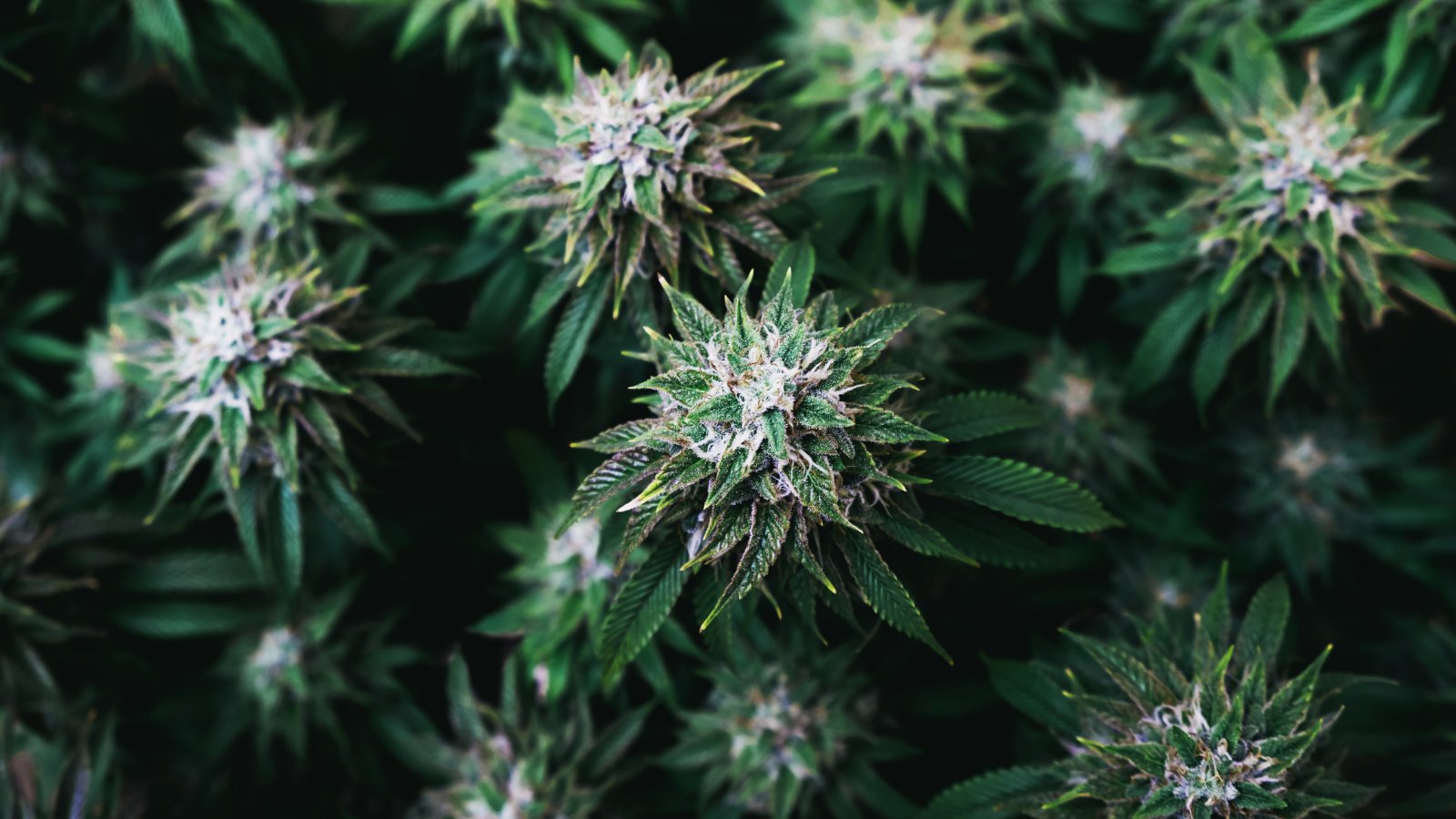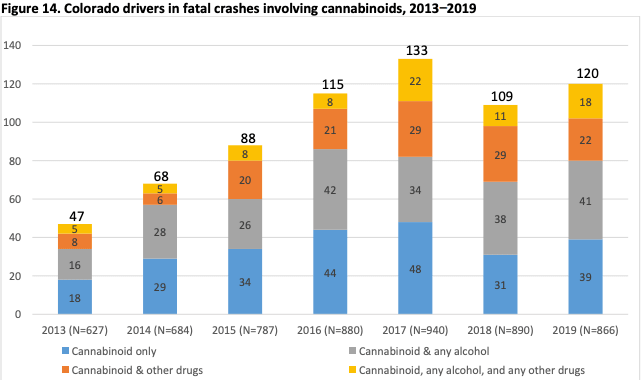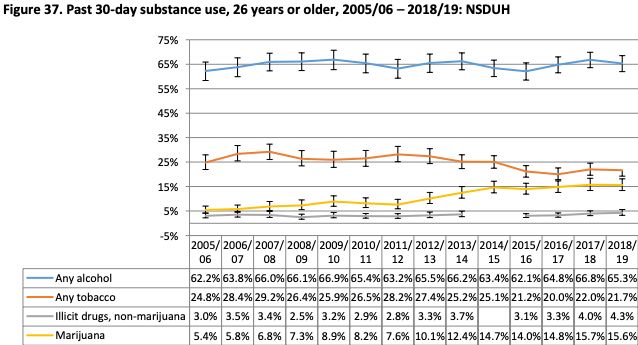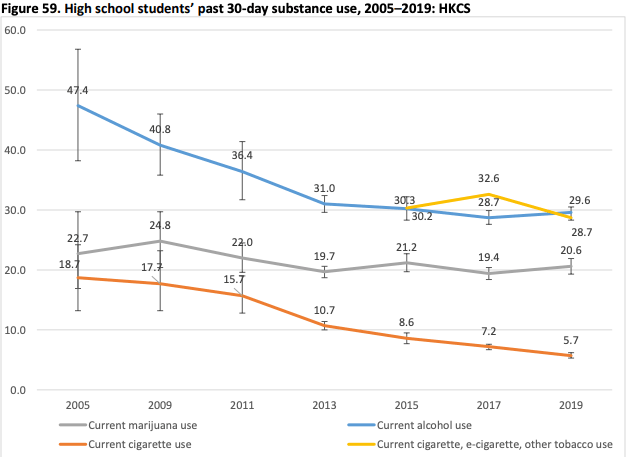
On November 6, 2012, Colorado citizens voted to legalize recreational marijuana. Since the first recreational dispensaries began opening in 2014, more than $10,940,865,212 worth of cannabis sales have been reported. Colorado was one of the first states to legalize medical and recreational marijuana and has served as an effective template for states that want to follow suit. Overall, public opinion on the legalization of marijuana has become less divisive over the past decade, and the stigma surrounding the plant has exponentially decreased. However, there is still only a limited amount of data that has been researched on the effects of its legalization. In their July 2021 report, the Colorado Division of Criminal Justice stated that:
“It is difficult to draw conclusions about the potential effects of marijuana legalization and commercialization on public safety, public health, or youth outcomes, and this may always be the case due to the lack of historical data… For example, the decreasing social stigma regarding marijuana use could lead individuals to be more likely to report use on surveys and also to health workers in emergency departments and poison control centers, making marijuana use appear to increase when perhaps it has not.”
Even though there is limited quantitative data on the effects of marijuana legalization in Colorado, several indicators illustrate growing patterns and trends that may provide beneficial insight on a national level. By analyzing the Colorado Divison of Criminal Justice’s report, as well as other supplemental reports, and breaking down the statistics into a basic pros/cons format, the societal effects of marijuana legalization in Colorado will become evident and will possibly give a look into the future effects of marijuana legalization.
In most cases, states vote to legalize marijuana because of its positive impact on tax revenue, individual health, or other aspects of society that can improve the quality of life. Medical marijuana programs, which strive to help individuals cope with various diseases, illnesses, and chronic pains, have also been played a large part in why states are pushing for legal cannabis. Legal marijuana has many positive aspects, but there are also important implications that cannot go unnoticed. As emphasized in the July 2021 report, both sides of the coin are equally important and can be organized by their specific indicators.
Public Safety
- “The total number of marijuana arrests decreased by 68% between 2012 and 2019, from 13,225 to 4,290.”
- “The number of marijuana-related [court] case filings declined 55% between 2012 and 2019, from 9,925 to 4,489.”
- “The proportion of individuals participating in DUI treatment with alcohol as the primary substance declined from 93% in 2012 to 84% in 2019.”
Arrests that involve non-violent crimes surrounding marijuana have put tens of thousands of Americans in jail. According to several studies, “African Americans are arrested for violating marijuana possession laws at nearly four times the rates of whites, yet both ethnicities consume marijuana at roughly the same rates.” If legalizing marijuana has led to a 68% decrease in overall marijuana arrests, then there is clear value in its legalization right off the bat (as there are fewer Americans in jail that can spend their time productively). Similarly, dealing with an arrest and fighting in court are expensive processes that not all can afford, and African-Americans have taken a majority of the legal burden regarding a plant that at least 67% of Americans believe should be legal. Even though all of the effects of marijuana legalization on public safety are not completely clear, it is evident that legalization helps decrease the number of Americans stuck in the prison complex system and dismantle institutionally racist practices.
- “In terms of organized crime, the number of court filings charged with the Colorado Organized Crime Control Act (C.R.S.18-17.104) that were linked to some marijuana charge increased from 31 in 2012 to 119 in 2017.”
- “The number of DUI summonses issued by the Colorado State Patrol in which marijuana-alone or marijuana-in-combination was recorded increased by 120% between 2014 (n=684) and 2020 (n=1,508).”
- “The number of fatalities with cannabinoid-only or cannabinoid-in-combination positive drivers increased 140%, from 55 in 2013 to 132 in 2019.”
- “The number of plants seized on public lands has fluctuated significantly over time, from 46,662 plants in 2012, to a high of 80,826 in 2017.”
While overall arrests for marijuana itself have gone down, there have been increases in arrests made for certain forms of organized crime, “transfer using parcel services” such as USPS, and driving under the influence of marijuana. There has been a consistent increase in positive THC tests among people who are on probation across all age groups, and fatalities of drivers who have only smoked weed have fluctuated but, in general, have increased since 2014. In Colorado, cannabis is reaching an equivalent status of alcohol in terms of how easy it is to obtain, and the main problem seems to be that users, growers, and sellers are becoming too relaxed with the plant and the laws surrounding it. Users, growers, and sellers of cannabis in Colorado need to understand more properly that, although the plant is legal in the state, there are still strict regulations and rules that must be followed, and it is still illegal on a federal level.

Public Health
- “The increase in marijuana use contrasts with a decline in tobacco use (down from 45.9% to 26.2%).”
- “The perception of great risk from once-per-month marijuana use decreased significantly in young adults in Colorado, from 18.5% to 7.6% in the period from 2005/06 to 2018/19 … while perceived risk for regular binge drinking increased from 26.1% in 2013/14 to 36.7% in 2018/19.”
- “There has been concern that, due to the cash-only nature of the industry, robbery would be prevalent but this has not been the case.”
The number of adults who use marijuana has increased since its recreational legalization; however, awareness of the dangers of other common drugs has increased while their use has either remained constant or decreased. Additionally, other public health indicators, such as suicide rates, have remained constant with no attribution to marijuana usage. It is significant that tobacco use has declined and that individuals have become more aware of the dangers of alcohol abuse because, according to the World Health Organization (WHO): “Almost six million people die from tobacco use and 2.5 million from harmful use of alcohol each year worldwide.” In comparison, marijuana is medically valuable, is virtually impossible to overdose on, and, in reality, “THC present in cannabis smoke should exert a protective effect against pro-carcinogens that require activation.” Marijuana has a strong potential to positively impact public health if it is used responsibly.
- “Since 2000, rates of hospitalizations and emergency department visits possibly related to marijuana increased.”
- “The number of calls to poison control mentioning human marijuana exposure increased over the past 10 years. There were 41 calls in 2006 and 276 in 2019.”
- “Nearly three-quarters (73.5%) of youth (10 to 17 years-old) in treatment for substance use report marijuana as their primary substance of use.”
From 2014-2019, the number of adults who reported using cannabis in the previous 30 days has steadily increased, which has not come without negative consequences. Since the most common effects of marijuana are “pleasant euphoria, a sense of relaxation, heightened sensory perception, laughter, altered perception of time, and increased appetite,” and that some forms, including edibles, take a few hours to kick in, some marijuana users consume more than their bodies can handle and end up in the hospital. “Severe panic attacks,” mental offsets, and Cannabis Hyperemesis Syndrome (CHS) have been the most frequently reported conditions of hospitalized marijuana patients, but in almost all cases, these are treatable non-life-threatening conditions. Most incidents that land a patient in a hospital from cannabis are preventable and are caused by accidental consumption, taking more than suggested, or trying for the first time in the wrong setting.

The Youth
- “The proportion of Colorado high school students reporting using marijuana ever in their lifetime remained statistically unchanged between 2005 and 2019.”
- “The percentage of high school students reporting past 30-day use also remained stable, with no significant changes between 2005 and 2019.”
- “The proportion of students trying marijuana before the age of 13 went down significantly in Colorado, from 9.2% in 2015 to 6.7% in 2019.”
- “[Youth] alcohol and cigarette use trended downward, with the largest reduction linked to current alcohol use, down from 47.4% in 2005 to 29.6% in 2019.”
- “The total number of juvenile marijuana arrests decreased from 3,265 in 2012 to 2,064 in 2019 (-37%).”
- “The drug expulsion rate decreased significantly from the 2010-2011 school year (90 per 100,000 pupils) to the 2018-2019 school year (35 per 100,000 pupils).”
- “In 2019, 20.6% of Colorado high school students reported using marijuana in the past 30-days compared to 21.7% of high school students nationally that reported this behavior.”
Under Colorado’s current statute, medical patients must be at least 18 years old, and recreational patients must be at least 21. To study the impact on the youth community in Colorado, the Colorado Division of Criminal Justice focused on “comprehensive school data, drug endangered children, and diversion to minors.” The youth community can be defined as anyone under 18. Most of the studies done zero in on how easily the youth can access marijuana, if it is present in their schools, how frequently it is used compared to other drugs, and its risk perception. The studies concluded that fewer juveniles were being arrested for marijuana after its legalization, there was no significant increase in its use among juveniles, and there have been fewer high-school expulsions related to the drug. Many opponents of legalization believe that allowing adults to access marijuana freely would positively correlate with increased youth use, but this is not the case. In fact, its legalization has had several positive effects on the youth community in Colorado.
- “Drug suspension rates increased from 391 (per 100,000 registered students) in the 2008-09 school year to 551 in 2010-11.”
In arguably the most important section of the study, there is very little evidence that suggests negative implications against Colorado’s youth. Although adults have become too relaxed in certain areas regarding legal cannabis, such as in traffic, they have remained protective over their stashes and have not allowed youth abuse to become a significant problem. Youth communities are so important within society because much of the body’s and brain’s development occurs during this stage of life. Several studies have reported that marijuana can have adverse implications on a teen’s developing brain and body. It is crucial to protect the youth and ensure that marijuana use does not affect their lifestyle until it is societally, mentally, and physically acceptable.

Additional Information
- “The total revenue from taxes, licenses, and fees increased 473% from calendar year 2014 to 2020, going from $67,594,325 up to $387,480,111.”
- “Between 2014 and 2020 marijuana excise taxes have contributed $487 million dollars directly to school construction or other public school needs.”
- “In December 2020, there were 85,814 individuals registered as medical marijuana cardholders. The most common conditions reported were severe pain (90%), muscle spasms (36%), and severe nausea (20%).”
- “The violent crime rate increased 26% from 2012 to 2019.”
Marijuana has created an enormous market in Colorado. Revenue from the plant has been exceedingly high for the state and has helped fund public projects, including new schools. Outside of the recreational market, the medical marijuana program in Colorado has helped to combat the diseases listed and others such as opioid addiction, post-traumatic stress disorder (PTSD), seizures, and even autism. Problems have arisen, including a steep increase in violent crimes, but not all of these implications can be directly linked to the legalization of marijuana. When recreational marijuana is both legal and strictly regulated, it has the ability to benefit society overwhelmingly.
Conclusion
The legalization of recreational cannabis in Colorado has had countless effects, both positive and negative. The plant is used socially, medically, and overall quite frequently by citizens of Colorado. The July 2021 report released by the Colorado Division of Criminal Justice provides an excellent look at the statistics of public safety, public health, youth impact, and additional sectors concerning legal cannabis. On the other hand, though, due to a lack of historical statistics and data, the report should be taken skeptically and with a grain of salt rather than interpreted straight-forwardly and conclusively. Research on the societal effects of legal recreational cannabis needs to continue at a high level to fully understand how it impacts individuals, families, communities, and society as a whole.